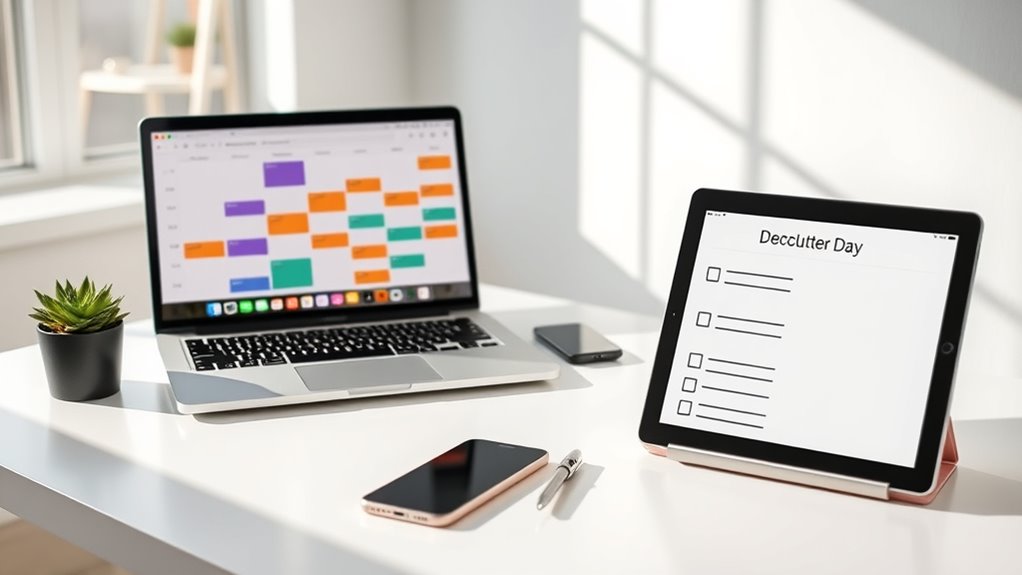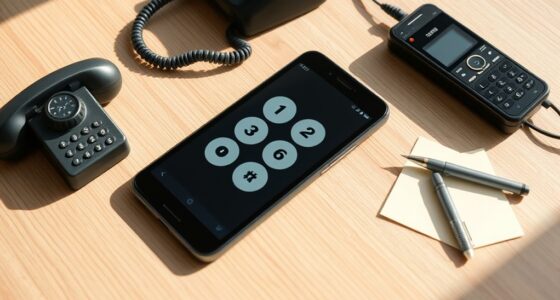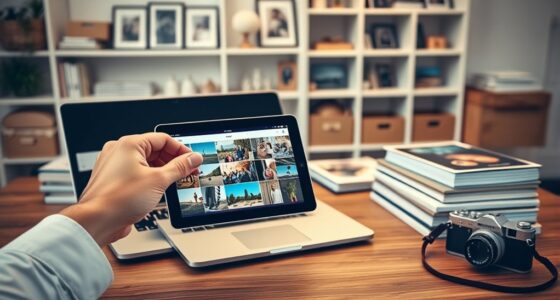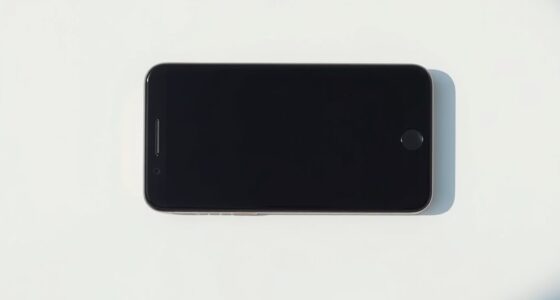Start your 7-day digital declutter by tackling your email inbox daily, deleting unnecessary messages and organizing important ones into folders. Limit social media use by logging out or setting specific times to check accounts. Turn off non-essential notifications and uninstall apps that don’t support your goals. Schedule regular digital maintenance sessions to stay on track. Keep consistent progress in small steps, and you’ll find a calmer, more focused digital environment waiting for you. Continue to learn how this plan can transform your habits.
Key Takeaways
- Dedicate specific days for email organization, deleting unnecessary messages, and creating filters for better inbox management.
- Schedule social media detox periods, log out, disable notifications, and limit usage to reduce digital overload.
- Turn off non-essential notifications and uninstall apps that do not support your goals to minimize distractions.
- Regularly review and adjust your digital habits, including social media and email routines, to maintain a clutter-free environment.
- Use tools to monitor screen time and digital activity, reinforcing consistent decluttering practices for long-term digital well-being.

In today’s digital world, clutter can quickly overwhelm your devices and drain your productivity. Whether it’s overflowing inboxes or endless scrolling on social media, these digital distractions keep you from focusing on what truly matters. The good news is that you can regain control with a focused digital declutter day. The first step is tackling email organization. Set aside dedicated time to go through your inbox, delete unnecessary messages, and create clear folders or labels for important emails. Unsubscribe from mailing lists you no longer read, and set rules to filter incoming messages automatically. This process not only reduces visual clutter but also ensures you can find critical emails quickly, saving you time and mental energy.
Once your email is streamlined, turn your attention to social media detox. Social platforms can be major time sinks, often pulling you into endless scrolling that distracts from your goals. To start your detox, log out of your accounts or temporarily disable notifications. This step helps break the habit of constantly checking your feeds. Use this time to reflect on how social media impacts your mood and productivity, and decide what boundaries you want to set moving forward. You might choose to limit your social media use to specific times of the day or delete apps from your devices altogether. Additionally, understanding content overload can help motivate you to reduce unnecessary digital clutter and regain focus.
Log out or disable notifications to break social media habits and set healthy usage boundaries.
While working through these steps, be mindful of your overall digital habits. Turn off non-essential notifications that pop up throughout the day, and consider uninstalling apps that don’t serve your priorities. This creates a cleaner digital environment that’s less likely to distract you. As you declutter, keep your goals in mind—whether it’s creating more space for meaningful work, reducing anxiety, or simply enjoying more quality offline time. Remember, the goal isn’t perfection but progress. Small, consistent adjustments like organizing your email and taking a social media detox can have a long-lasting impact.
Finally, set a plan to maintain your digital declutter. Schedule weekly or monthly sessions to tidy up your email and review your social media habits. Use tools or apps that help monitor your screen time and email flow, so you stay on top of your digital environment. By dedicating just one day to these tasks, you’ll create a more organized, intentional digital space that supports your productivity and well-being. Taking control of your digital life isn’t a one-time effort; it’s an ongoing process that pays off in clarity, focus, and peace of mind.
Frequently Asked Questions
How Often Should I Repeat the Digital Declutter Process?
You should repeat the digital declutter process every three to six months to maintain good file organization and protect your privacy. Regularly clearing out unnecessary files, emails, and apps helps you stay organized and reduces security risks. Set reminders to review your digital space periodically, ensuring your information stays private and your devices run smoothly. Consistent decluttering saves time and keeps your digital life manageable.
What Tools Are Best for Digital Decluttering?
Think of digital decluttering like tidying a cluttered closet—you need the right tools. Apps like Clean Master or Files by Google excel at file organization, helping you sort and delete unnecessary files. For app management, tools like AppCleaner or iMazing help uninstall apps and reclaim space. These tools streamline your digital space, making it easier to find what you need and keep everything organized, much like a well-maintained closet.
How Do I Handle Sentimental Digital Items?
When handling sentimental digital items, start with photo organization. Create specific folders for memorable events and give each file a clear, consistent name using descriptive file naming. This helps you easily find and cherish your memories later. Then, go through each item, keeping only those that truly matter. Don’t rush—taking time to thoughtfully sort and label guarantees your sentimental digital items stay meaningful and well-preserved.
Can Digital Decluttering Improve Productivity?
Imagine your digital workspace as a garden; when overgrown, productivity stalls. Digital decluttering, like pruning, clears chaos and boosts efficiency. When you organize emails and manage photos, you find files faster and reduce stress. Studies show decluttering can increase productivity by up to 20%. By dedicating time to clean up your email inbox and photo library, you create a streamlined environment that helps you focus and accomplish more daily.
What Are Common Pitfalls During Digital Decluttering?
You might stumble into common pitfalls during digital decluttering if you neglect proper file organization or overlook privacy protection. Rushing through the process can lead to deleting important files or leaving sensitive information exposed. To avoid this, take your time, categorize files thoughtfully, and guarantee you securely delete or store data. Keeping privacy protection in mind helps prevent future risks, making your digital space both clean and safe.
Conclusion
By following this 7-day plan, you’ll discover how a simple declutter can unexpectedly free up mental space and boost your productivity. Sometimes, just when you think you’re clearing your digital clutter, you stumble upon forgotten files or helpful apps that make things easier. It’s almost like the universe nudges you in the right direction. So, keep going—you might be surprised how a little digital tidying can lead to big, unexpected benefits.









